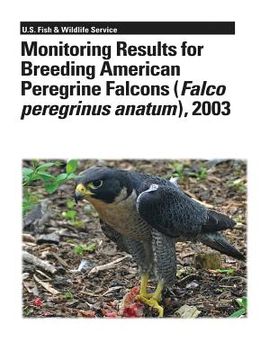Monitoring Results for Breeding American Peregrine Falcons (Falco peregrinus anatum), 2003 (en Inglés)
Reseña del libro "Monitoring Results for Breeding American Peregrine Falcons (Falco peregrinus anatum), 2003 (en Inglés)"
In 2003, the U.S. Fish and Wildlife Service (Service) implemented the first of five nationwide monitoring efforts for American Peregrine Falcons (Falco peregrinus anatum) (Peregrine Falcons) as described in the Service's post-delisting monitoring plan (USFWS 2003). More than 300 observers monitored 438 Peregrine Falcon territories across six monitoring regions. Monitoring in the Southwestern monitoring region fell short of the monitoring goal, where 36 of the targeted 96 territories were monitored; efforts are underway to implement full-scale monitoring in that region in 2006. The five other monitoring regions surveyed sufficient territories to meet the statistical criteria described in the post-delisting monitoring plan. Our estimates of territory occupancy, nest success, and productivity were above the target values that we set in the monitoring plan for those nesting parameters. The history of Peregrine Falcons in the United States, their population decline caused by environmental contaminants and their recovery following bans on those chemicals, is a tale of conservation success. By the late 1960's Peregrine Falcons had disappeared from the eastern United States and Midwest and were substantially reduced in the Western United States, Canada, and Mexico (Kiff 1988, Enderson et al. 1995). The Service officially listed Peregrine Falcons as endangered in 1970 under the Endangered Species Conservation Act of 1969, a precursor of the Endangered Species Act (ESA) of 1973 (for a history of listing actions see USFWS 1999) and set recovery goals based on abundance and productivity in four regions of the United States. In some of these regions it also established goals for reduced contaminant effects (USFWS 1982a, 1982b, 1984, 1991, 1993; Figure 1). By 1999, recovery goals had been almost completely met in all regions, primarily due to a ban on the use of DDT and other chlorinated hydrocarbons and to the successful captive breeding, rearing, and release of over 6,000 Peregrine Falcons (White et al. 2002). Peregrine Falcons were removed from the Service's List of Threatened and Endangered Species on August 25, 1999 (USFWS 1999). From 1999 to 2003 the Service developed a postdelisting monitoring plan (USFWS 2003) for Peregrine Falcons in cooperation with other Federal and State agencies, Tribes, and nongovernmental organizations (USFWS 2003). This plan is designed to detect a significant decline in territory occupancy, nest success, or productivity in six monitoring regions across the United States. These three indices of population health were low between 1950 and 1980 when Peregrine Falcon populations declined severely; the three measures then rebounded during population recovery (Cade et al. 1988, Enderson et al. 1995, USFWS 1999, White et al. 2002). The monitoring plan (USFWS 2003) calls for monitoring every three years beginning in 2003 and ending in 2015. These five monitoring periods meet the requirement of ESA (to monitor ". . . for not less than five years . . .") and the three year interval spreads the monitoring over 13 years, reflecting the concern of the Service for the long-term future of Peregrine Falcon populations. The monitoring plan is also designed to collect baseline information on contaminant loads in each monitoring region through the annual collection and archiving of addled eggs and feather samples. Those samples will be analyzed and reported in future years. This report is of results from Peregrine Falcon monitoring in 2003, which yielded data on territory occupancy, nest success, and productivity from across the United States. This is the first report of post-delisting monitoring results for Peregrine Falcons.

